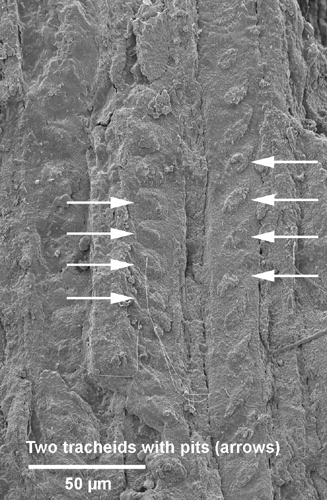By George Beccaloni
The fossil tree
Dr Paul Kenrick of The Natural History Museum, London, examined a small fragment of the fossil wood from the grave monument using an scanning electron microscope and found that the wood has tracheids with closely spaced pits, similar to those known from Protocupressinoxylon purbeckensis Francis, an approximately 146 million years old conifer of the subfamily Cheirolepidiaceae, found in the Lower Purbeck Formation (Lower Dirt Bed or Great Dirt Bed) in the Portland/Swanage area of Dorset.
It is known that Wallace accompanied the American Palaeontologist Lester F. Ward on a field trip to the Isle of Portland in 1894 to collect fossil wood (see Ward, 1896) and one of the species collected on this trip was even named Araucarioxylon wallacei Knowlton after him. Interestingly, several pieces of fossil wood were found in the garden of Old Orchard after Wallace died by the Tyndale-Biscoe family, who rented the house from Wallace's son in 1916 (the late Mrs Barbara Waterman nee Tyndale-Biscoe pers. comm.). These fragments, although smaller, were very similar in appearance to the fossil on Wallace's grave, so it is possible that the trunk on the grave was collected by Wallace and that it was taken from Old Orchard following his death.
 |
|
SEM of fossil wood from monument on Wallace's grave by Paul Kenrick. Copyright The Natural History Museum, London |
References
Ward, L. F. 1896. Some analogies in the Lower Cretaceous of Europe and America. United States Geological Survey Annual Report 16: 469-910.
